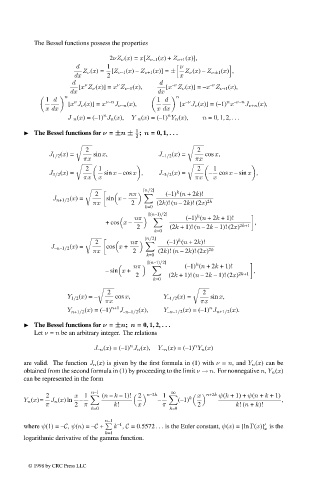Page 779 - Handbook Of Integral Equations
P. 779
The Bessel functions possess the properties
2νZ ν (x)= x[Z ν–1 (x)+ Z ν+1 (x)],
d 1 ν
Z ν (x)= [Z ν–1 (x) – Z ν+1 (x)] = ± Z ν (x) – Z ν±1 (x) ,
dx 2 x
d ν ν d –ν –ν
[x Z ν (x)] = x Z ν–1 (x), [x Z ν (x)] = –x Z ν+1 (x),
dx dx
n n
1 d ν ν–n 1 d –ν n –ν–n
[x J ν (x)] = x J ν–n (x), [x J ν (x)] = (–1) x J ν+n (x),
x dx x dx
n
n
J –n (x)=(–1) J n (x), Y –n (x)=(–1) Y n (x), n =0, 1, 2, ...
1
The Bessel functions for ν = ±n ± ; n =0, 1, ...
2
2 2
J 1/2 (x)= sin x, J –1/2 (x)= cos x,
πx πx
2 1 2 1
J 3/2 (x)= sin x – cos x , J –3/2 (x)= – cos x – sin x ,
πx x πx x
[n/2] k
2 nπ (–1) (n +2k)!
J n+1/2 (x)= sin x –
πx 2 (2k)! (n – 2k)! (2x) 2k
k=0
[(n–1)/2]
nπ (–1) (n +2k + 1)!
k
+ cos x – ,
2 (2k + 1)! (n – 2k – 1)! (2x) 2k+1
k=0
[n/2] k
2 nπ (–1) (n +2k)!
J –n–1/2 (x)= cos x +
πx 2 (2k)! (n – 2k)! (2x) 2k
k=0
[(n–1)/2]
nπ (–1) (n +2k + 1)!
k
– sin x + ,
2 (2k + 1)! (n – 2k – 1)! (2x) 2k+1
k=0
2 2
Y 1/2 (x)= – cos x, Y –1/2 (x)= sin x,
πx πx
n
Y n+1/2 (x)=(–1) n+1 J –n–1/2 (x), Y –n–1/2 (x)=(–1) J n+1/2 (x).
The Bessel functions for ν = ±n; n = 0,1,2, ...
Let ν = n be an arbitrary integer. The relations
n
n
J –n (x)=(–1) J n (x), Y –n (x)=(–1) Y n (x)
are valid. The function J n (x) is given by the first formula in (1) with ν = n, and Y n (x) can be
obtained from the second formula in (1) by proceeding to the limit ν → n. For nonnegative n, Y n (x)
can be represented in the form
n–1 ∞
2 x 1 (n – k – 1)! 2 n–2k 1 k n+2k ψ(k +1)+ ψ(n + k +1)
x
Y n (x)= J n (x)ln – – (–1) ,
π 2 π k! x π 2 k!(n + k)!
k=0 k=0
n–1
–1
where ψ(1) = –C, ψ(n)= –C + " k , C = 0.5572 ... is the Euler constant, ψ(x) = [ln Γ(x)] is the
x
k=1
logarithmic derivative of the gamma function.
© 1998 by CRC Press LLC
© 1998 by CRC Press LLC
Page 764

